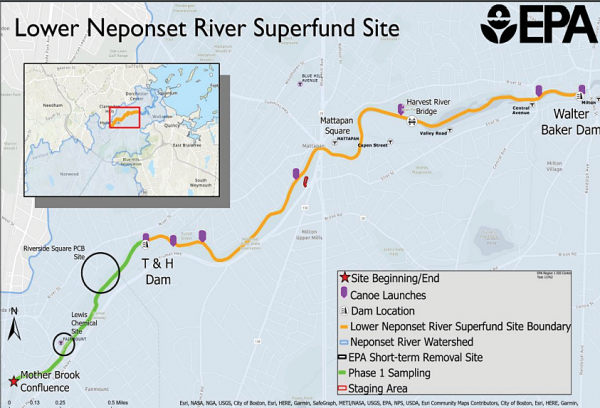March 6, 2024

Federal environmental officials gave the public an update on plans to clean up the contaminated Lower Neponset River along a 3.7-mile stretch of the waterway from Mother Brook in Hyde Park to the Walter Baker Dam on the Dorchester-Milton line in Lower Mills at a meeting in Hyde Park last Tuesday night (Feb. 27).
The section was added to the “National Priorities List” by the Environmental Protection Agency in March 2022— making it eligible for funding as a so-called “Superfund” site.
Natalie Burgo, a project manager for the EPA, told attendees that the agency is currently in the “characterization” phase, in which officials are investigating the extent of the contamination and developing the best course of action.
The Neponset is contaminated with chemicals called “polychlorinated biphenyls,” more commonly known as PCBs, which were used in a variety of industrial products for decades but were banned in the United States in 1976 because they are highly carcinogenic. They can cause liver damage and a variety of skin conditions if a person is exposed for extended periods of time.
A major point conveyed through last week’s meeting was that fish from the river should not be eaten by anyone, but especially children, people who are pregnant or expect to become pregnant, and nursing mothers. People who don’t belong to that category are advised against eating fish from the river altogether as well, or at the very least to limit consumption to two meals per month. White sucker and American eel were explicitly named as species that should not be consumed by anyone.
The EPA has been sampling most extensively in the more upstream areas of the river. Burgo said because of time and cost restraints with contractors, they haven’t yet reached sampling by the Tileston & Hollingsworth Dam in Hyde Park near the Milton town line.
The next sampling session that will happen this year, she said, will focus on the section between the T&H Dam and the Walter Baker Dam in Lower Mills. She also said that because of the build-up of sediments and, therefore, PCBs, the T&H Dam “has been identified as a priority dam for removal.” She noted that it would have to be a multiagency decision between several other state entities, including the state’s Department of Conservation and Recreation.
The meeting also discussed the need to form a community advisory group, or CAG, that would not only hold the proxy of the community and voice concerns to the EPA and related groups but would also be able to distribute information to the public.
For more information on the Neponset River Superfund Site or on community advisory groups, please visit epa.gov/neponsetriver.


